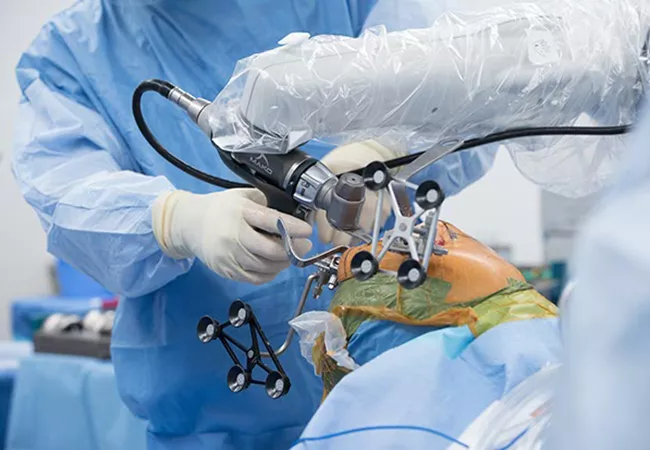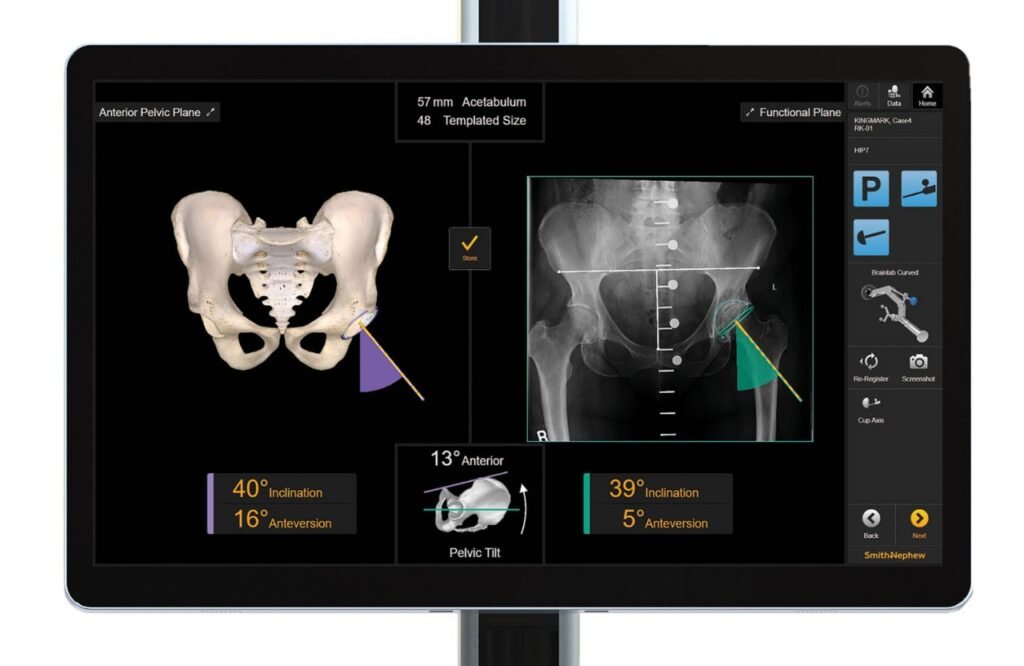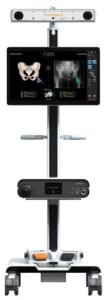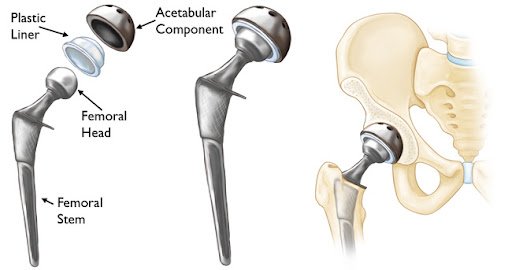Robotic Hip Replacement at RNH Hospital


Your hip is a ball-and-socket joint, the socket is formed by the pelvis, and the ball is the femoral head (the top of your thighbone). When healthy, cartilage cushions these bones and allows smooth movement. But injury, disease, or wear-and-tear can damage this structure, causing pain and stiffness that affect walking and daily activities.
Robotic hip replacement is an advanced form of hip replacement surgery that uses robotic-assisted technology to help surgeons perform the procedure with greater precision and accuracy.

During surgery, the robotic system:
- Creates a 3D model of your hip using a CT scan.
- Helps the surgeon plan the procedure in detail, determining the ideal size, position, and alignment of the new hip components.
- Guides the surgeon’s instruments with real-time feedback, ensuring the implant fits your unique anatomy perfectly.
- The robot doesn’t perform the surgery on its own, the surgeon stays in complete control throughout the procedure.
Needs a Robotic Hip Replacement
Robotic hip replacement is ideal for people who:
- Suffer from severe hip arthritis (osteoarthritis, rheumatoid arthritis, or post-traumatic arthritis)
- Experience persistent hip pain that limits movement or daily activities
- Have not found relief with medications, physical therapy, or walking aids
- Require hip surgery due to fracture, avascular necrosis, or tumor damage
- Most patients are between 50 and 80 years old, but younger or older individuals may also be candidates based on their overall health and lifestyle.
How the Artificial Hip Is Designed
The new, artificial hip joint mimics the natural ball-and-socket structure and typically consists of four parts:
- Metal Socket – Replaces the damaged hip socket.
- Liner – Allows smooth, friction-free movement of the new joint.
- Ball (Metal or Ceramic) – Replaces the femoral head.
- Metal Stem (Rod) – Inserted into the thighbone to support the new ball.
Types of Prosthesis
- Uncemented Prosthesis: Allows bone to grow into it naturally over time, durable, but with a longer recovery.
- Cemented Prosthesis: Attached using bone cement, better suited for older or less active patients.
- Muscle-Sparing Prosthesis: Modern approach that avoids cutting through muscles, reducing pain and speeding recovery.
How Robotic Hip Replacement Surgery Works
Pre-Surgical Planning
A 3D CT scan of your hip is uploaded to the robotic system. Your surgeon uses this data to:
- Assess your hip’s exact shape and alignment
- Plan precise implant placement
- Simulate the surgery before entering the operating room
During Surgery
- You’ll receive either general anesthesia (you’re asleep) or regional anesthesia (numb from the waist down).
- The robotic arm assists the surgeon in removing the damaged bone and cartilage with millimeter-level precision.
- The new hip components are then implanted and aligned perfectly according to the pre-operative plan.
The entire operation usually takes 1–3 hours.
Benefits
- Greater Precision: The robotic system ensures accurate implant positioning.
- Less Pain & Blood Loss: Smaller incisions and tissue sparing techniques.
- Faster Recovery: Many patients walk the same or next day.
- Longer Implant Life: Better alignment means less wear and tear.
- Improved Mobility: Restores natural hip motion and stability.
Why Choose RNH Hospital for Robotic Hip Replacement
- We use state-of-the-art robotic systems that ensure unmatched precision in implant positioning and joint alignment.
- Our highly skilled surgeons combine years of experience with the latest robotic-assisted techniques for optimal surgical outcomes.
- Each procedure is customized using 3D imaging to match your unique anatomy, ensuring a natural fit and faster recovery.
- Robotic precision minimizes tissue damage, leading to reduced pain, less blood loss, and quicker rehabilitation.
- From diagnosis to post-surgery physiotherapy, our multidisciplinary team ensures complete, compassionate care at every stage.
Non-Robotic Hip Replacement Surgery

Your hip is a ball-and-socket joint, one of the strongest and most flexible joints in your body.
- The socket is part of your pelvic bone.
- The ball is at the top of your thighbone (femoral head).
When this joint becomes damaged or diseased, it can cause severe pain and limit your ability to move or perform daily activities. That’s where hip replacement surgery comes in, replacing the damaged joint with durable artificial parts designed to function just like the natural joint. Hip replacement is most common in people aged 50–80, often due to arthritis, which destroys the cartilage that cushions your bones. Without this cushion, bones rub together, causing pain and stiffness.
Common Causes:
- Osteoarthritis: Age-related wear and tear of the joint.
- Rheumatoid Arthritis: An autoimmune disease causing chronic joint inflammation.
- Traumatic Arthritis: Joint damage following an injury.
You may be a candidate for hip replacement if you:
- Have persistent hip pain that doesn’t improve with medication or therapy.
- Find it difficult to walk, sleep, or perform everyday activities.
- Have tried supports, braces, or physical therapy without relief.
How Is the New Hip Constructed?
A modern hip replacement is made of four key components:
- Metal Socket, Replaces the natural hip socket.
- Liner allows smooth movement between the ball and socket.
- Metal or Ceramic Ball Replaces the femoral head (top of the thighbone).
- Metal Stem (Rod) anchors the implant inside the thighbone.
Types of Prosthesis:
- Uncemented Prosthesis: Bone naturally grows into the implant over time (common for younger, active patients).
- Cemented Prosthesis: Fixed in place with bone cement for faster recovery (ideal for older or less active patients).
Muscle-Sparing Hip Replacement
- A newer technique that avoids cutting through major muscles, leading to less pain and faster recovery.
- Anterior Approach: Incision made in the front of the thigh.
- Posterior Approach: Incision made at the back of the hip.
Preparing for Surgery
If your hip replacement isn’t an emergency, your doctor will schedule it several weeks ahead.
Use this time to:
- Improve your fitness and lose excess weight if needed.
- Stop taking certain medications, such as blood thinners.
- Arrange your home to make recovery easier, keep essentials within reach and prepare meals in advance.
- You’ll need to stop eating and drinking after midnight on the night before surgery.
- During the Procedure
The surgery takes place in a hospital operating room and lasts 1–3 hours.
During the Procedure
The surgery takes place in a hospital operating room and usually lasts 1 to 3 hours.
You will receive either:
- General anaesthesia (you’ll be asleep), or
- Regional anesthesia (your lower body is numbed, often combined with sedation).
During surgery, your surgeon will:
- Make an incision over the hip to access the joint.
- Remove the damaged bone and cartilage from the hip socket and the top of the thighbone.
- Prepare the bone surfaces to fit the new prosthetic components precisely.
- Secure the implant components either cemented (fixed using bone cement) or uncemented (allowing bone to grow into the implant naturally).
- Check the new hip’s movement and stability before closing the incision.
After Surgery & Recovery
- Most patients begin walking with support within 24–48 hours after surgery.
- Physical therapy starts early to help restore strength, flexibility, and balance.
- Most people return to light activities within 4–6 weeks and regain normal movement within 3–6 months.
Regular follow-ups help ensure your new hip joint is healing and functioning properly.
Benefits
- Time-tested and highly effective for most patients
- Relieves chronic hip pain and stiffness
- Restores smooth, natural movement of the hip joint
- Improves mobility, balance, and quality of life
- Lower cost compared to robotic-assisted procedures
Why Choose RNH Hospital for Non-Robotic Hip Replacement
- Our highly experienced orthopaedic surgeons specialize in conventional hip replacement with accuracy and care.
- Each patient receives a personalized surgical plan tailored to their hip condition, bone quality, and lifestyle.
- We use proven, minimally invasive techniques that reduce pain, speed up recovery, and ensure lasting results.
- Our dedicated in-house physiotherapy team guides you through every step of your rehabilitation journey for optimal recovery.
- At RNH Hospital, we believe in compassionate care, clear communication, and ongoing follow-up ensuring comfort, confidence, and complete patient satisfaction.
